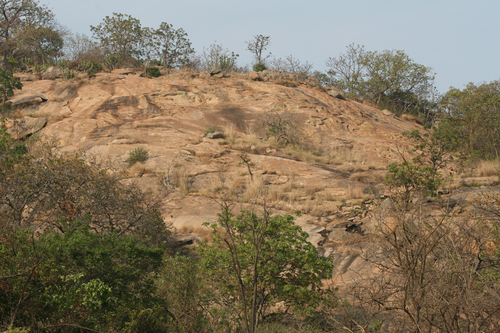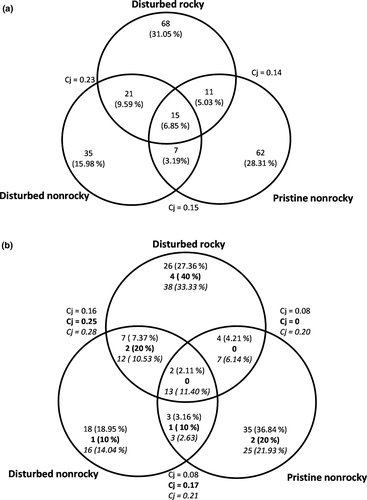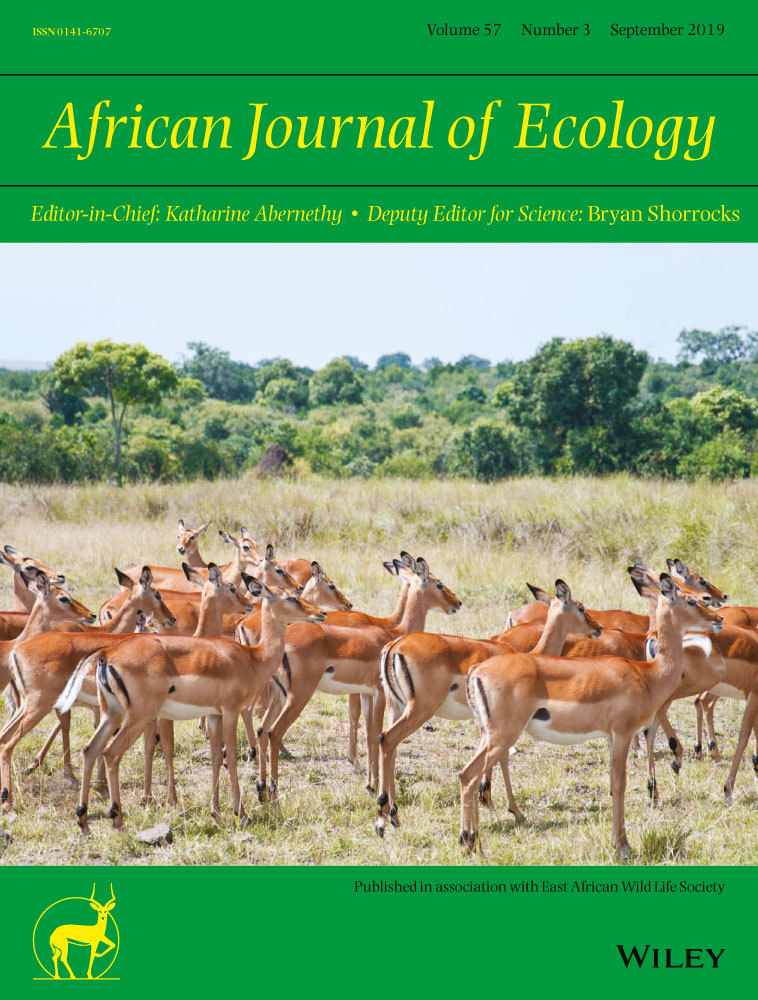Diversity and composition of flightless arthropods on rock outcrops and adjacent vegetation in the savannah, Mpumalanga Province, South Africa
1 INTRODUCTION
Savannah vegetation is characterised by structural complexity, greater plant species richness and a variety of environmental conditions (Botha, Siebert, & Berg, 2016). Fire determines plant species richness and composition in the savannah (Bond & Parr, 2010). Savannah is a continuous grassland with trees scattered and/or dense woodland patches (Bond & Parr, 2010). The nature of the savannah increases arthropod heterogeneity (Botha et al., 2016) because different arthropods require different habitats and environmental conditions (Yekwayo, Pryke, Roets, & Samways, 2017).
Anthropogenic activities, such as disturbance through residential development, invasion by exotic species and conversion to agricultural land (Mauda, Joseph, Seymour, Munyai, & Foord, 2018; Veldman & Putz, 2011), decrease plant diversity, thereby reducing arthropod diversity because of their positive association with plants (Rhoades, Davis, Tinkham, & Hoffman, 2018). Furthermore, high plant diversity increases availability of mesofilters, such as leaf litter and logs, which serve as nesting sites and/or food for some arthropods (Loyola, Brito, & Ferreira, 2006; Uno, Cotton, & Philpott, 2010).
Transformation of natural landscapes because of residential development decreases specialist arthropods while increasing generalists (Magura, Horváth, & Tóthmérész, 2010; Vergnes, Pellissier, Lemperiere, Rollard, & Clergeau, 2014). Generalists increase because of being adapted to a variety of habitats and environmental conditions (Bizuet-Flores, Jiménez-Jiménez, Zavala-Hurtado, & Corcuera, 2015). Arthropods, particularly with limited dispersal abilities, such as millipedes, are affected because residential development leads to habitat fragmentation. Benítez-Malvido et al. (2016) reported that fragments are unfavourable habitat for beetles compared to continuous forests. In addition, flightless arthropods are restricted to specific habitats in which resources are available (Yekwayo et al., 2017), hence the greater sensitivity to habitat modification.
In South Africa, impact of rockiness on arthropods has been investigated in grassland (Crous, Samways, & Pryke, 2013,2014) and fynbos (Yekwayo, Pryke, Gaigher, & Samways, 2018), which is dominated by small leaves and evergreen shrubs (Mucina & Rutherford, 2006). Although Crous et al. (2013) reported an increase in grasshopper and butterfly diversity with increasing rockiness, Yekwayo et al. (2018) observed that rockiness did not affect arthropod diversity. There is little information known about the influence of rockiness on arthropods in the savannah, yet small features within the landscape serve as mesofilters, which are important for arthropod conservation (Hunter, 2005). Furthermore, rockiness increases heterogeneity in the landscapes, which is consistent with Crous et al. (2014) observation of different butterfly composition in rocky and nonrocky areas. Here we compared species richness, abundance and composition of flightless arthropods between rocky and nonrocky sites and investigated also the effect of disturbance on flightless arthropods in the savannah.
2 MATERIALS AND METHODS
The study was undertaken in the savannah that occurs near residential areas (25°23′4.32″S 30°58′30.72″E) in Mbombela and in two nature reserves (Sterkspruit: 25°9′43.74″S 30°33′50.52″E and Barberton: 25°36′17.64″S 30°58′40.80″E) in Mpumalanga Province, South Africa. Sixteen sites were selected, eight in nonrocky areas and eight in rocky areas. Rocky sites were characterised by rock outcrops (about 2,500 m2) that occur within a matrix of the savannah vegetation (Figure 1). From the 16 sites, 12 were in disturbed areas while four were pristine in protected areas. Disturbed sites were approximately 3 km from human settlements, while pristine sites were inside protected areas with less anthropogenic activities (approximately > 20 km from human settlements). Interaction between disturbance and rockiness was used to classify site categories. Eight sites were on rock outcrops that were in disturbed savannah, and were referred to as “disturbed rocky.” Four sites in disturbed nonrocky savannah were referred to as “disturbed nonrocky.” In nature reserves, there were no rock outcrops, and as a result, four sites (two in each reserve) were selected as “pristine nonrocky sites.” Sites were >300 m apart to avoid pseudo-replication. Elevation of study sites ranged between 677 and 1,776 m asl. Sampling was conducted in summer and winter of 2017, each site was visited once during each season, and data from the two seasons were pooled for analyses.

Each site was stratified into four sub-sites. At each sub-site, six pitfall traps that were arranged in a rectangular-shape (depending on the depth of the soil to allow digging, particularly in rocky sites) were set out leaving the rim of the jars flush with the ground surface. Pitfall traps (plastic cups 6 cm diameter and 9 cm depth) were quarter-filled with 100% ethylene glycol. Sampling was consistent across all sites, with pitfall traps left open in the field for seven days. In addition to pitfall traps, which target a range of active flightless arthropods, we used active searching as a complementary technique, especially for arthropods living under rocks and among logs (Samways, McGeoch, & New, 2010). At each site, active searching of arthropods (by two people for 20 min per transect) was conducted along two transects that were 50 m long and 2 m wide. Active searches were conducted once per season. All collected specimens were preserved in 100% ethanol. Data from the two sampling techniques were pooled for analyses. After arthropods were sorted to morphospecies and identified, they were assigned to functional guilds: predators (beetles, spiders and scorpions), detritivores (beetles, millipedes and cockroaches) and herbivores (beetles).
Species richness and abundance were compared between rocky and nonrocky sites, and between disturbed and pristine sites using generalised linear mixed models in R, using the lme4 package (Bates, 2005). For species richness and abundance, we created two models. The first model had rockiness and disturbance as fixed factors, while elevation was a random factor. The second model had an additional fixed factor (interaction between rockiness and disturbance), and interaction results only were reported from this model. Poisson and negative binomial distributions (Bolker et al., 2009) were used for species richness and abundance, respectively. The models provided chi-square and p-values. Analyses were performed for overall arthropods, predators and detritivores. Herbivores were not analysed separately because of the small number (10) of species.
Effect of disturbance and rockiness, and the interaction between these factors on overall arthropods, predators and detritivores were determined using permutational multivariate analysis of variance (PERMANOVA) in PRIMER 7. Two models were created; the first model had rockiness and disturbance as fixed factors and elevation nested within a sampling area as a random factor. Although the second model had an additional fixed factor (interaction between rockiness and disturbance), we reported interaction results only from this model. Square-root transformation was used to reduce the weight of common species (Anderson, 2001). Similarities in species composition between categories of sites (disturbed rocky and disturbed nonrocky; disturbed rocky and pristine nonrocky; and disturbed nonrocky and pristine nonrocky) were determined using the Jaccard index of similarity. Similarities between site categories and number of species unique to each site category were presented using Venn diagrams, which were created for overall arthropods, predators, detritivores and herbivores.
3 RESULTS AND DISCUSSION
A total of 1,303 individuals from 219 morphospecies were sampled. Singletons and doubletons contributed 64% of total species. Predators were most species rich (52.05%) followed by detritivores (43.38%) and herbivores (4.56%). Results showed that effects of rockiness and/or disturbance on arthropods depend on the diversity measure and/or functional guild considered. For example, community composition of all arthropods was influenced by disturbance, while species richness or abundance was not.
Contrary to our results, previous studies have shown that pristine vegetation support greater arthropod richness and abundance than disturbed areas (Cajaiba et al., 2018; Mauda et al., 2018; Van Nuland & Whitlow, 2014). In our study, species richness and abundance of all arthropod guilds were not influenced by any of the measured factors (rockiness, disturbance and the interaction between these factors). However, we cannot ignore the role of each habitat in supporting specialist species (Figure 2a). Many species of detritivores are specialists, which were restricted to pristine nonrocky sites (Figure 2b). High number of unique species of detritivores in pristine sites could be associated with the fact that pristine habitats are usually rich in plant species (Melliger, Braschler, Rusterholz, & Baur, 2018). According to Rhoades et al. (2018), rich understory vegetation increases arthropod diversity because arthropod association with plants is usually species-specific (Bennett & Gratton, 2013). Furthermore, detritivores, such as certain millipede species, respond negatively to habitat changes (Car, 2010). In addition, our study showed that not all predators are generalists, and some are specialists as we recorded a greater number of unique species in disturbed rocky sites (Figure 2b).

Unlike for species richness, disturbed and pristine sites supported different composition of overall arthropods (Pseudo-F = 2.02, p = 0.003), predators (Pseudo-F = 1.73, p = 0.02) and detritivores (Pseudo-F = 2.16, p = 0.008). Although we did not measure plant characteristics, Melliger et al. (2018) reported that plant composition changes with the level of disturbance. Furthermore, plant composition plays a role in determining arthropod composition (Vilardo, Tognetti, González-Arzac, & Yahdjian, 2018). Therefore, we can link observed dissimilarities in assemblages between pristine and disturbed sites with different plant assemblages in these areas. Furthermore, disturbed habitats experience different environmental conditions from undisturbed habitats (Van Nuland & Whitlow, 2014). Disturbed habitats support fewer microhabitats, such as leaf litter and logs (Loyola et al., 2006; Van Nuland & Whitlow, 2014), which are important niche for flightless arthropods (Neoh et al., 2015). Our results support previous studies, which demonstrated that arthropod assemblages are altered by the land use type (Mauda et al., 2018; Melliger et al., 2018; Van Nuland & Whitlow, 2014).
Rocky and nonrocky sites supported different composition of detritivores (Pseudo-F = 2.01, p = 0.008). Structurally, rocky sites were more open, with rock outcrops covering most of the site (Figure 1), while nonrocky sites were grasses with clusters of trees. These differences in site structure may have influenced environmental conditions at each site. For example, rocky sites had greater sunlight and wind exposure than nonrocky sites. Additionally, rocky sites had shallow soils, which lead to lower moisture retention because of higher levels of evaporation. Thus, it is not surprising that rocky and nonrocky sites supported different assemblages of detritivores. However, composition of predators did not differ between rocky and nonrocky sites, which might be due to their generalist nature. Therefore, our results support previous studies, which showed that the effect of rockiness on arthropod composition is taxon-dependent (Crous et al., 2013; Yekwayo et al., 2018). Rockiness affected assemblages of butterflies but not grasshoppers (Crous et al., 2013). Although rockiness did not affect ants, cockroaches and mites, impact of rockiness on beetle composition was evident when there was an interaction with fire (Yekwayo et al., 2018).
Interaction between rockiness and disturbance revealed differences in composition of all arthropods between nonrocky sites (disturbed and pristine) and between disturbed rocky and pristine nonrocky sites. For detritivores, dissimilarities were observed even within disturbed sites (rocky and nonrocky) indicating higher degree of specialisation. Habitat structure, which may be influenced by disturbance, influences arthropod composition. Habitat specialisation of detritivores and herbivores was shown also by the Jaccard index of similarity with few/no species shared between sites (Figure 2b). However, for predators, composition in disturbed rocky and disturbed nonrocky sites was similar. Rocky sites were rock outcrops within a matrix of the savannah, thus the possibility of composition overlap due to some arthropods using both rock outcrops and adjacent vegetation as foraging or shelter sites. It has been reported that the surrounding matrix affects arthropods within a patch (Driscol, Banks, Barton, Lindenmayer, & Smith, 2013; Yekwayo, Pryke, Roets, & Samways, 2016). Furthermore, the generalist nature of predators was evident when the Jaccard index of similarity revealed greater composition overlap between all paired site categories (Figure 2b).
In summary, our study highlighted that savannah vegetation with rocky and nonrocky areas increases arthropod heterogeneity and therefore enhances arthropod conservation. Despite the fewer pristine sites we had, the study emphasised that pristine habitats should be conservation areas of priority. However, the role of disturbed habitats in arthropod conservation should not be underestimated, especially in Africa, where human population growth rate is alarming and natural landscape are transformed continuously.
ACKNOWLEDGEMENTS
We wish to thank the University of Mpumalanga and the National Research Foundation for funding the project and the Mpumalanga Tourism and Parks Agency for access to the nature reserves. Bongani Sibuyi, Lwazi Lubelo, Lindokuhle Gumede, Phina Masinga, Njabulo Mathebula and Khodani Magadani are thanked for helping with field and laboratory work and Ansie Dippenaar-Schoeman for helping with the identification of spiders.




